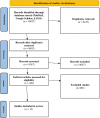Indications and Recommendations for Tracheostomy in Trauma Population With COVID-19 Infection: A Review of the Literature
- PMID: 34743584
- PMCID: PMC10251180
- DOI: 10.1177/00031348211054711
Indications and Recommendations for Tracheostomy in Trauma Population With COVID-19 Infection: A Review of the Literature
Expression of concern in
-
Expression of Concern.Am Surg. 2025 Mar;91(3):464-472. doi: 10.1177/00031348241305412. Epub 2025 Jan 10. Am Surg. 2025. PMID: 39791244 Free PMC article. No abstract available.
Abstract
This review explores the current body of evidence pertaining to tracheostomy placement in COVID-19 seropositive patients and summarizes the research by tracheostomy indications, timing, and procedure. Literature review was performed in accordance with the 2020 PRISMA guidelines and includes 12 papers discussing protocols for adult patients seropositive for COVID-19. The studies demonstrated high mortality rates after tracheostomy, especially in geriatric patients, and suggested a multifactorial determination of whether to perform a tracheostomy. There was inconclusive data regarding wait time between testing seropositive, tracheostomy, and weaning off of ventilation. COVID-19 generally reaches highest infectivity between days 9 and 10; furthermore, high early mortality rates seen in COVID-19 may confound mortality implicated by tracheostomy placement. Due to the aerosol-generating nature of tracheostomy placement, management and maintenance, techniques, equipment, and personnel should be carefully considered and altered for COVID-19 patients. With surgical tracheostomy, literature suggested decreased usage of electrocautery; with percutaneous tracheostomy, single-use bronchoscope should be used. The nonemergent exchange of tracheostomy should be done only after the patient tested negative for COVID-19. Placement of tracheostomy should only be considered in COVID-19 patients who are no longer transmissible, with rigorous attention to safety precautions. Understanding procedures for airway maintenance in a respiratory disease like COVID-19 is imperative, especially due to current shortages in ventilators and PPE. However, because of a lack of available data and its likelihood of change as more data emerges, we lack complete guidelines for tracheostomy placement in COVID-19 seropositive patients, and those existing will likely evolve with the disease.
Keywords: COVID-19 infection; timing of tracheostomy; tracheostomy; trauma outcomes.
Conflict of interest statement
The author(s) declared no potential conflicts of interest with respect to the research, authorship, and/or publication of this article.
Figures
References
-
- Combes A, Luyt CE, Nieszkowska A, Trouillet JL, Gibert C, Chastre J. Is tracheostomy associated with better outcomes for patients requiring long-term mechanical ventilation? Crit Care Med. 2007;35(3):802-807. - PubMed
-
- Elkbuli A, Narvel RI, Spano PJ, 2nd, et al.Early versus late tracheostomy: is there an outcome difference? Am Surg. 2019;85(4):370-375. - PubMed
-
- Freeman BD, Borecki IB, Coopersmith CM, Buchman TG. Relationship between tracheostomy timing and duration of mechanical ventilation in critically ill patients. Crit Care Med. 2005;33(11):2513-2520. - PubMed
-
- de Franca SA, Tavares WM, Salinet ASM, Paiva WS, Teixeira MJ. Early tracheostomy in severe traumatic brain injury patients: a meta-analysis and comparison with late tracheostomy. Crit Care Med. 2020;48(4):e325-e331. - PubMed
Publication types
MeSH terms
LinkOut - more resources
Full Text Sources
Medical


